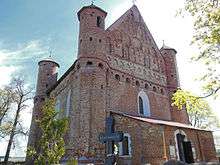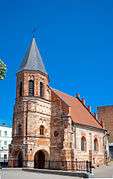Belarusian Gothic

The term Belarusian Gothic (Belarusian беларуская готыка [belaruskaya hotyka], Russian белорусская готика [belorusskaya gotika]) is primarily used to describe the architectural style of ecclesiastical buildings erected in the 15th and 16th centuries. The style was used in regions of modern-day Belarus, Lithuania, and eastern Poland.
These buildings have elements typical of Gothic architecture design, such as lofty towers, flying buttresses, pointed arches and vaulted ceilings, but they also feature elements that would not typically be considered Gothic by central and western European standards.
Conditions of building
With the baptism of the Grand Prince Vladimir the Great and the Christianization of the Kievan Rus', Russian architecture became heavily influenced by Byzantine architecture.
During the 13th century and the first decades of the 14th century, the Russian principalities in present-day Belarus were eventually subjugated by the Grand Duchy of Lithuania, a pagan state that was expressing resistance against the Catholic Teutonic Order. The Grand Duchy became a major power in the 14th century, featuring a developed nobility. Rural populations descended from Russians. The official language was Ruthenian.[1]
After Władysław II Jagiełło was crowned as the king of Poland in 1386, the countries of Poland and Lithuania united which caused an increase in communication in western and southern Europe, especially after the definitive victory of the union against the Teutonic Order in 1466 (Second Peace of Thorn).
It was during this period that the Gothic style came to the Slavic regions, however, in central and southern Europe, it was already being displaced by Renaissance architecture.
The Southern areas of present-day Lithuania had a Lithuanian majority and was never a policy of Russia. Southern Lithuania and Belarus share many of the same architectural features. The Orthodox Cathedral of the Theotokos, Vilnius[2] in Vilnius, was constructed. This was before the Renaissance style had arrived in central Europe, and it was when the Lithuanian state had not yet become Catholic .
-
Cathedral of Ss. Boris and Gleb,[1] Navahrudak, southern façade
-

Cathedral of Ss. Boris and Gleb, 1519–1630, interior
-

Mir Castle, 16th century
- ^ www.radzima.org (Belarusian portal on monuments in Belarus, Lithuania and Podlachia) Царква Святых Барыса й Глеба | Навагрудак (description of Boris-and-Gleb-Church in Belarusian)
- ^ Roman Aranazy, Dzieje rezydencji na dawnych kresach Rzeczypospolite (Residences in former districts of the (Polish) republic today (in Polish), 1993, S. 209, Hniezna
- ^ radzima.org – touristic presentation of Hnezna
The Belarusian Gothic is a merging of Byzantine, Gothic, and Renaissance architectures.
- Material: Some buildings bear a resemblance to the Brick Gothic of northern German design, and some of the other structures are completely plastered.
- Arches: The church windows mainly have pointed arches, but blind arcades and Lombard bands mainly have round arches.
- Vaults: Most of the churches have rib vaults, but there are also simplistic heavy vaults, such as those found in Romanesque and Byzantine architecture.
- Entire shapes: Most of the churches are fortified. In some of them, this character is emphasized. They have a short nave and four small towers in each corner. Other churches have an ordinary high western bell tower.
-

St. John Baptist in Zapyškis, Lithuania
- ^ Šv. Gertrūdos bažnyčia (in Lithuanian) Archived September 21, 2007, at the Wayback Machine.
References
- ↑ "Within the [Lithuanian] Grand Duchy, the Ruthenian lands initially retained considerable autonomy. The pagan Lithuanians themselves were increasingly converting to Orthodoxy and assimilating into the Ruthenian culture. The grand duchy's administrative practices and legal system drew heavily on Slavic customs, and Ruthenian became the official state language. Direct Polish rule in Ukraine since the 1340's and for two centuries thereafter was limited to Galicia. There, changes in such areas as administration, law, and land tenure proceeded more rapidly than in Ukrainian territories under Lithuania. However, Lithuania itself was soon drawn into the orbit of Poland."
from Ukraine. (2006). In Encyclopedia Britannica. - ↑ Description of the Cathedral of the Theotokos - in Russian
- ↑ "Exploring Castles".
Sources
- Nigel Roberts, Belarus, p. 185 (google books)
- Rainer Lindner, Historiker und Herrschaft: Nationsbildung und Geschichtspolitik in Weißrußland im 19. und 20. Jahrhundert, Verlag Oldenbourg 1999, ISBN 3-486-56455-2, S. 256, II. Nation und Geschichte im Stalinismus → 3. Rivalität der Mythen (Nation-building and policy of history in Belarus in the 19th & 20 centuries) – in German
- Archives of Belarus, Church Architecture
- Беларуская готыка ў пабудове культавых будынкаў XV-XVI стст. – Belarusian Gothic in religious buildings of the 15th and 16th centuries (in Belarusian, very much illustrated)
| Wikimedia Commons has media related to Belarusian Gothic. |
.jpg)

